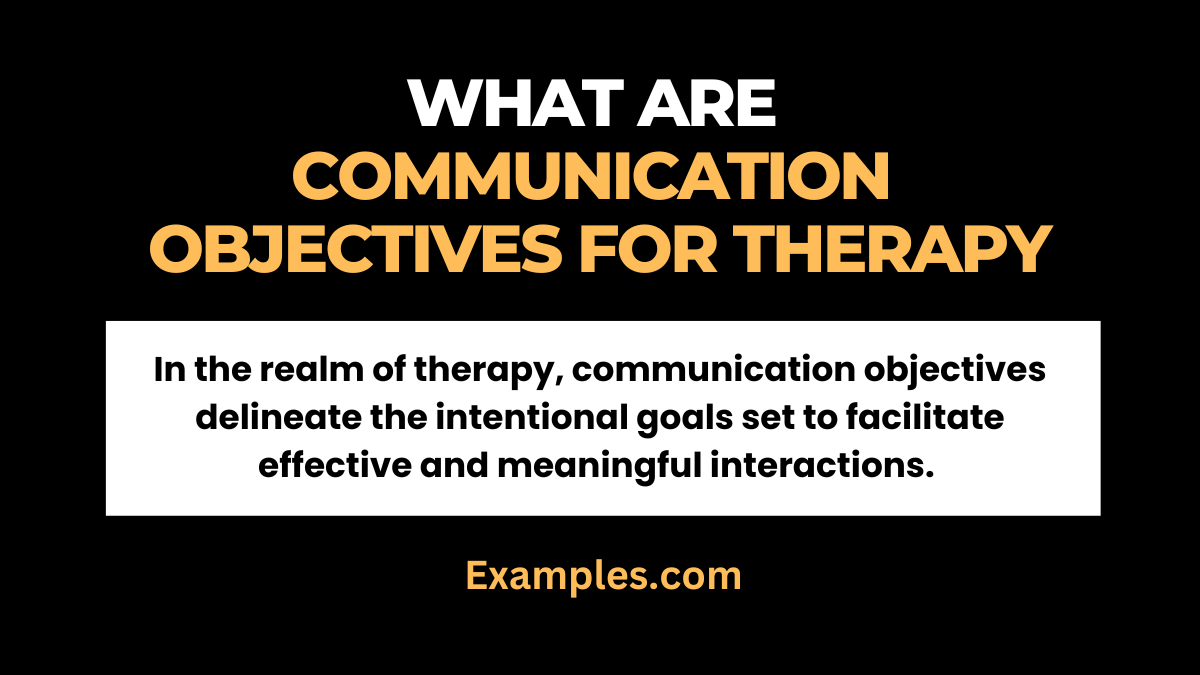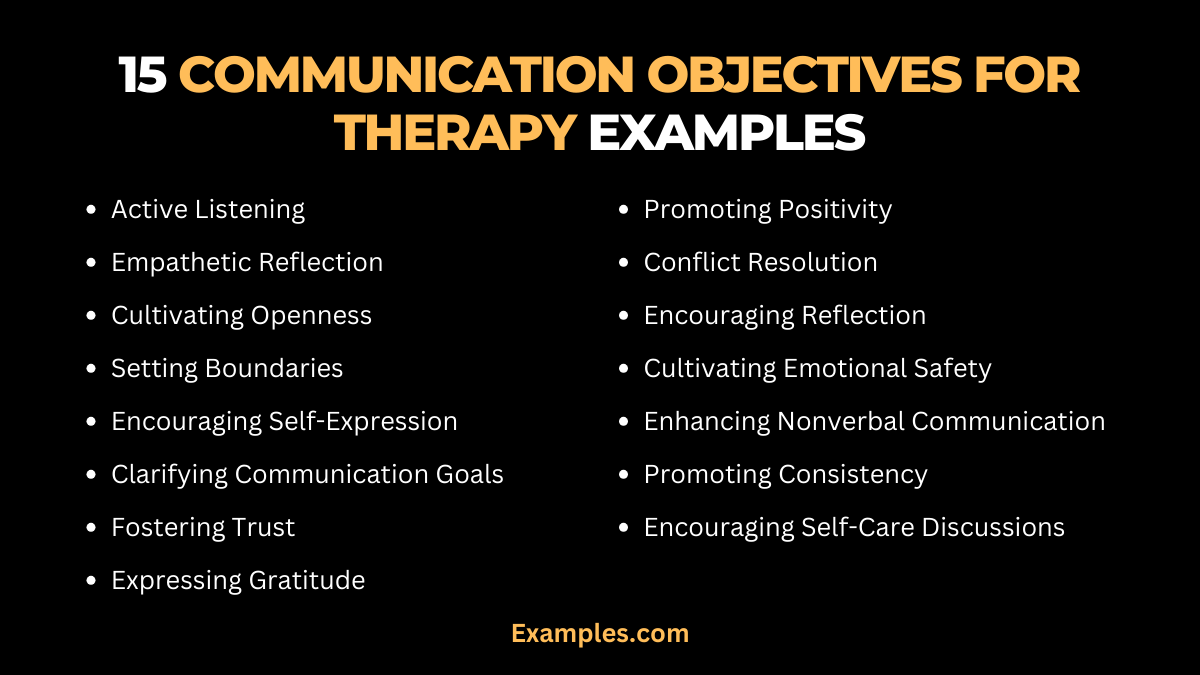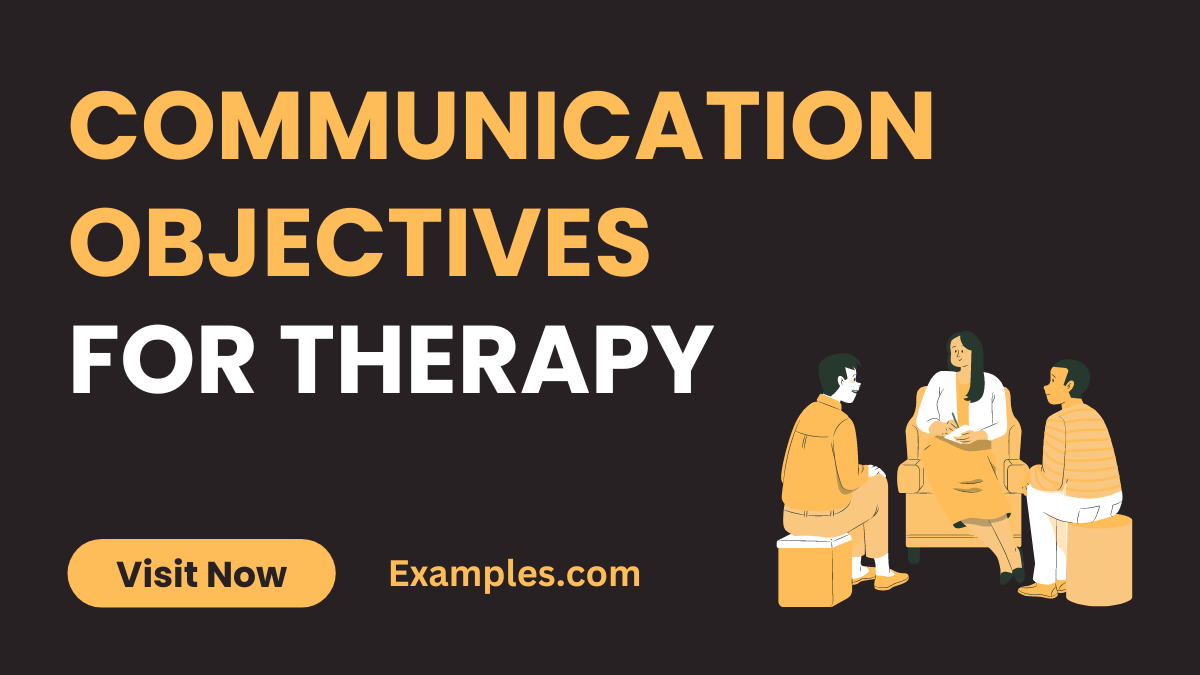14+ Communication Objectives for Therapy Examples
Embark on a transformative journey with our comprehensive guide to Communication Objectives for Therapy. Uncover the art of fostering connection, both at work and home, through therapeutic communication strategies. Navigate through real-life communication examples that illuminate the path to emotional healing and enhanced well-being. Whether you seek workplace harmony or personal growth, this guide provides actionable insights and expert tips to elevate your communication skills and enrich your therapeutic journey.
What are Communication Objectives for Therapy

In the realm of therapy, communication objectives delineate the intentional goals set to facilitate effective and meaningful interactions. These objectives aim to enhance interpersonal connections, foster emotional healing, and promote overall well-being. Whether in a therapeutic workplace setting or personal environment, these objectives serve as a roadmap, guiding individuals towards clearer expression, empathetic understanding, and a harmonious exchange of thoughts and emotions. Understanding and implementing these objectives are integral to optimizing the therapeutic process.
15 Communication Objectives for Therapy Examples
Explore 15 potent communication objectives for therapy designed to elevate your emotional well-being. From fostering active listening to nurturing empathy, these objectives empower individuals in therapeutic environments to navigate challenges and cultivate meaningful connections.

- Active Listening:
Example: “In therapy, practice active listening by repeating what you hear and validating feelings. Say, ‘I hear you, and your experiences are valid.'” - Empathetic Reflection:
Example: “Enhance empathy through reflective statements. For instance, ‘It sounds like you’re feeling overwhelmed. How can we address this together?'” - Cultivating Openness:
Example: “Promote openness by encouraging honest expression. Use, ‘Share your thoughts without judgment. This is a safe space.'” - Setting Boundaries:
Example: “Establish boundaries by stating, ‘Let’s define our communication boundaries to ensure a respectful and supportive therapeutic relationship.'” - Encouraging Self-Expression:
Example: “Empower self-expression with prompts like, ‘Take your time and share what’s on your mind. Your voice matters.'” - Clarifying Communication Goals:
Example: “Define communication goals collaboratively. Example: ‘Our goal is to improve mutual understanding. What specific objectives do you have?'” - Fostering Trust:
Example: “Build trust through transparency. Communicate, ‘I am here to support you, and our interactions are confidential.'” - Expressing Gratitude:
Example: “Infuse gratitude into communication. Say, ‘I appreciate your openness today. Let’s continue fostering this positive dialogue.'” - Promoting Positivity:
Example: “Inject positivity with affirmations. Express, ‘Your resilience and commitment to growth are truly admirable.'” - Conflict Resolution:
Example: “Navigate conflicts constructively. Use, ‘Let’s discuss any concerns openly to find resolutions that benefit both of us.'” - Encouraging Reflection:
Example: “Encourage self-reflection with questions like, ‘What insights have you gained about yourself since our last session?'” - Cultivating Emotional Safety:
Example: “Ensure emotional safety by saying, ‘This space is judgment-free. Feel free to share without fear of criticism.'” - Enhancing Nonverbal Communication:
Example: “Acknowledge nonverbal cues. Say, ‘I notice your body language. Can we explore what it may signify?'” - Promoting Consistency:
Example: “Establish communication consistency. Remind, ‘Regular sessions provide stability and foster a deeper therapeutic connection.'” - Encouraging Self-Care Discussions:
Example: “Initiate self-care conversations. Ask, ‘How can we incorporate self-care practices into your daily routine for overall well-being?'”
Communication Objectives for Therapy at Work
Explore tailored communication objectives for therapy at work to enhance professional well-being. These objectives foster a supportive environment, encouraging open dialogues and addressing workplace challenges for a healthier, more connected team.
- Workplace Conflict Resolution:
Example: “Implement strategies like ‘Reflective Listening’ to resolve conflicts efficiently. Boldly state, ‘Let’s address workplace conflicts together to create a harmonious team.'” - Enhancing Team Collaboration:
Example: “Promote collaboration with ‘Team Huddles.’ Say, ‘Our objective is to enhance teamwork through regular huddles where ideas flow freely.'” - Stress Management at Work:
Example: “Combat workplace stress with ‘Mindful Breaks.’ Encourage, ‘Take mindful breaks to alleviate stress and foster a positive work environment.'” - Promoting Inclusivity:
Example: “Foster inclusivity with ‘Diverse Perspectives.’ Express, ‘Our goal is to embrace diverse perspectives for a richer and more inclusive work environment.'” - Building Professional Boundaries:
Example: “Establish boundaries with ‘Clear Expectations.’ Communicate, ‘Let’s set clear expectations to ensure a respectful and professional workplace.'”
Communication Objectives for Therapy at Home
Discover personalized communication objectives for therapy at home designed to nurture personal well-being. These objectives empower individuals to cultivate healthy relationships, navigate challenges, and foster a supportive home environment.
- Family Conflict Resolution:
Example: “Resolve family conflicts through ‘Family Meetings.’ Boldly state, ‘Our objective is to address conflicts constructively during regular family meetings.'” - Open Parent-Child Communication:
Example: “Foster open communication with ‘Quality Time Dialogues.’ Encourage, ‘Create quality time dialogues to strengthen the parent-child bond.'” - Strengthening Partner Relationships:
Example: “Build partner relationships with ‘Weekly Check-ins.’ Say, ‘Our goal is to strengthen our relationship through weekly check-ins and open conversations.'” - Promoting Emotional Safety:
Example: “Create emotional safety with ‘Safe Space Declarations.’ Express, ‘Let’s declare our home a safe space for open expression and emotional support.'” - Encouraging Individual Reflection:
Example: “Encourage self-reflection with ‘Personal Growth Journaling.’ Use, ‘Our objective is to foster personal growth through individual reflection and journaling.'”
What is the Goal of Communication Therapy?
Communication therapy, also known as speech or language therapy, aims to enhance an individual’s communication skills and overall verbal and nonverbal expression. The primary goal is to address and overcome communication challenges, fostering effective and meaningful interactions. Whether dealing with speech disorders, language delays, or social communication difficulties, the overarching objective is to empower individuals to express themselves clearly, engage in successful conversations, and navigate social situations with confidence.
- Speech Enhancement: Communication therapy focuses on refining speech sounds, pronunciation, and fluency, helping individuals articulate words more clearly and confidently.
- Language Development: For those with language delays, therapy aims to improve vocabulary, grammar, and comprehension, facilitating effective verbal expression and comprehension.
- Social Communication Skills: The goal extends to enhancing nonverbal cues, understanding social nuances, and developing pragmatic language skills crucial for successful social interactions.
- Cognitive Communication: Communication therapy addresses cognitive-communication challenges, such as memory, attention, and problem-solving, to ensure comprehensive communication development.
- Confidence Building: Through personalized strategies and exercises, the therapy aims to boost individuals’ confidence in their communication abilities, encouraging active participation in various settings.
In conclusion, Communication Objectives for Therapy provide a tailored approach to enhance verbal and nonverbal skills. With a focus on speech, language, and social communication, therapy aims to empower individuals, fostering independence and confidence. Through personalized strategies and measurable objectives, this comprehensive guide illuminates the transformative impact of communication therapy on individual lives, promoting successful interactions and improved quality of life.



